This is one of only SIX known tin ingots (as of 2025) from San Francisco assayer Stephen Molitor. Stephen Molitor was the son of A. Molitor, considered one of the great California Gold Rush assayers and one of the men originally involved with the U.S. Assay Office. In January 1859 Augustus and his son formed a new company called S, Molitor and Company. By then Stephen had worked in British Columbia during the Fraser River gold rush of 1857-1858 as well as in San Francisco with his father during earlier years. A third brother named Titus also worked for the firm.
S. Molitor and Company’s business in San Francisco flourished for a while. Then Stephen took off for a gold rush in San Diego County, but that did not last long. Molitor was then off to Helena, Montana and the Montana Gold Rush, then to Deadwood in the early 1880’s as part of the Black Hills Gold Rush, which was home to United State’s largest single gold mine, the Homestake Minng Company.
Tin Discovery at Dakota Territory
It was in Dakota that Stephen Molitor became part of a new type of gold rush. Tin had been discovered by prospectors while panning for gold. A heavy brown mineral called cassiterite was holding firm in the bottom of the pan with the gold after the black sand was removed, and caused little excitement at first. It was first found in the northern Black Hills in 1876 by a Colorado prospector, Richard Pearce. The second discovery was in the southern Black Hills is 1877. Assayer Theo Vosberg and Fred Cross were the first to recognize the tin in bullion. Molitor must have been intrigued by this discovery.
Tin Creates a Gold Rush in Dakota
There was no rush for tin at first. It was an anomaly in the miner’s gold bullion, another heavy metal that got in the way, but did not seem to be of importance. Certainly its value as pure bullion seemed to pale in comparison to gold, hence the tin issue was sort of set aside for awhile, but not completely ignored. All that changed in 1883 when A. Simmons of Rapid City sent ore specimens to San Francisco for analysis from the Etta mine. Once cassiterite was recognized as a primary ore mineral in the samples, excitement began. The Etta had been mining mica, which was used for stove windows. With the discovery of tin, however, mica mining came to a halt.
The Etta property was bought by the Harney Peak Tin Mining, Milling, and Manufacturing Co. in 1884. A similar group had started the Harney Gold Mining Co. about the same time. During this period, tin prospecting was at a height. Molitor’s business would have been booming for gold, silver and tin assays. Numerous companies, including the American Tin Co. which was partially owned by Molitor, were active. Beginning in 1885, hundreds of mining claims changed hands. It was reported by some that several mills were built, and a few thousand pounds of tin were produced.
The Etta mine built a 100 ton per day mill for the tin ores in 1884, but real production did not begin until 1886. They ran about 400 tons of ore and produced 7 tons of tin. They stopped in May of 1886 because the tailings had too much ore in them. A report and evaluation by a qualified mining engineer was needed.
The two most active areas were in the Keystone area of the southern Black Hills near the Etta Mine, and near Tinton, on the Wyoming-South Dakota border in the northern Black Hills. One of the early discoveries of tin in the Tinton area was by an African-American. In fact, the mining district there was inappropriately named Nigger Hill, rather than after the man’s true identity, which will take more research to uncover. This is the region that Stephen Molitor jumped into as an experienced assayer and a mining man.
Molitor and the American Tin Co.
Molitor and his partner Trebor staked a group of at least 13 claims in 1885-6 and incorporated themselves the American Tin Co., with their corporate office at 53 Broadway in New York City. The results of the tin assays from ores on their claims were reported in Mineral Resources of the United States in 1886. The ore ranged from a low of 0.5% tin to 5.5% tin. Their claims were located on three different pegmatite-quartz veins which spanned a mile in length. By mid 1886, they had a shaft ten feet deep and an open cut 35 feet long exposing the ore. This was a period of high activity in the area, and many others were also developing their prospects by open cuts and shafts. The American Tin Co. expanded their holdings to 53 mining claims. They also set up a sister company, the Cleveland Tin Co. San Francisco assayer John Taylor also got in on the fray and staked claims there as well. It was at this time that Molitor probably poured the ingot, using it and others, for promotional purposes. At least two of these ingots survive today.
When the Etta mill shut down, the miners sensed a collapse. Prospecting for tin slowed. Most men returned to the quest for gold, leaving the search for tin, which was relatively poorly understood, to others.
While the literature states that several mills were built, in fact only one mill was built, and less than ten tons of tin were actually produced. Other trial mills may have been built, but none were as substantial as the Etta mill on the Harney property. It was philosophically better to state that thousands of pounds of tin were produced, rather than a few tons were mined. Big numbers sound better, particularly to potential investors. Though there were more than 500 tin claims staked, few made production stage, and none ever developed into the commercial success that the miners had hopes for. The boom had bust.
Sometime in 1885 a British company was organized to acquire all of the principal tin properties in both districts. They sent four men to Dakota to evaluate the mines, led by M. Vincent. Forty tons of ore were shipped to England. The ore was tested by Fred Claudet, the assayer for the Bank of England and Johnson, Mathey & Co. which showed 2.8% tin. A second shipment was made later that yielded 4.6% tin. Famous geologist William P. Blake, who had written the exhaustive paper on native gold specimens in California in 1885, was called in to examine the property. A trial run of 400 tons produced 7 tons of tin.
A new company was formed. They made such wild claims in Britain about the richness of the ore grades, that the Engineering and Mining Journal felt it necessary to fully expose the exaggerated extravagance of expectations of value. The sales of the securities thus collapsed.
Engineers wrote a report suggesting an average grade of $5.20 per ton with a reserve of about 90,000 tons. The securities were sold via the Harney Peak Consol. Tin Co. Limited, and $1.5 million was subsequently spent without production of one pound of tin. The reported grade was far too low to be considered ore, and even if all the reserves were mined, the gross product would have been less than one third of the money expended. A scandal was in the air.
They didn’t give up. By the end of 1892, they had redone the mill and begun the production of tin. But production was less than three months. They shut down all operations by February, 1893. The British shareholders began a suit in American courts alleging fraud and misrepresentation by the managers. A receiver was appointed from New York. Work on the property continued for a few years with promising results, but no production. By 1900, the properties were sold to two new ventures, The Niagara Tin Smelting Co. and the North American Tin Co. Intermittent prospecting and minor production took place for more than twenty years.
The Tin Business in America
Tin was imported into America for our domestic use. It is estimated that from 1880 to 1885, about 33,000 to 41,000 tons of tin were produced annually worldwide. Tin sold on the open market. The price of tin was subject to greater fluctuations than other metals on account of the operations of speculators, according to David Day in 1886. They ranged from 17.12 cents per pound to 22.12 cents per pound in 1885 alone. This is about $400 per ton, or equivalent. By comparison, if the miners in Dakota could produce a quantity of 5% tin ore, it would have been worth $20 per ton, equivalent to one ounce per ton gold ore, which was the approximate average ore grade of the local gold mines. Thus the tin ores rendered equal excitement to gold because the ores were worth about the same.
At the time, America was also an exporter of tin products. We exported about $160,000 to $500,000 per year. We imported tin in the form of ingots, grains, and sheets; about 225,000 tons valued at about $18 to $25 million per year. Our internal production was nil, thus the high degree of interest in the potential of tin mined in America. The country consumed about 10,000 tons per year.
Tin as a precious metal
Tin was not considered a precious metal because it was not a primary metal of banking commerce in world trade, though it had been in ancient times. As such, data on discoveries and production were left out of many of the classic mining references that were funded by Congress chiefly to report on precious metals.
The amount and purity of tin were measured both in rocks and in ingots by conventional assayers. Cassiterite, the primary ore mineral of tin, is dense. Its specific gravity is about 7, or 7 times heavier than water. In comparison, galena, the lead sulfide mineral, has a specific gravity of 7.4; quartz is 2.6; argentite (silver sulfide) is 7.3; silver is about 10.5; pyrite (fools gold) is about 5; magnetite is also 5. Gold is 19 (19 times heavier than water) in its pure form, less when in electrum form combined with silver; Thus a miner panning gold would routinely find the tin in the form of cassiterite at the bottom of his pan in the heavy metals after the magnetite was removed.
The ingot inscription refers to a tin and gold mining area in the Black Hills of South Dakota, discovered by African Americans. Author Hyman Palais explained the origin of the name of the “Consolidated Nigger Hill Tin Mines” in an article “Black Hills Miners’ Folklore” in California Folklore Quarterly, Vol. 4, No. 3. (July, 1945), pp. 256: “Another story tells how a group of Negroes from Montana came to the Hills in the early days of the gold rush and asked some miners where they should go to work. The miners jokingly advised them to try the top of a near-by hill, the least likely spot they could think of. Much to the surprise of everyone, luck crowned their efforts, and these Negroes found more gold in this out-of-the-way place… than many of the gulch miners had discovered below.” The area was also found to have the largest deposit of tin in North America, so much so that it also became known as “Tinton”.
Article above taken from: https://holabirdamericana.liveauctiongroup.com/Stephen-F-Molitor-Nigger-Hill-Tin-Ingot-Deadwood-D-T_i28118997
Stephen F. Molitor, Assayer. American Tin Mining Company. Deadwood, Dakota Territory. Tin ingot.


Overall appearance of Fine to Very Fine. Deep gray color. Fairly well formed for this small sized ingot, one probably made as a sample more than for commercial uses. Some minor roughness, location soft and runs partially off the edge. One of just three such tin ingots with this assayer’s stamp known to the cataloguer, the other two being numbers 68 and 69 in Holabird-Kagin’s Fall, 2006 fixed price list offering of the Robert Bass Collection, where the most extensive history of Molitor and tin mining ever published in a numismatic source may be read. The cataloguer notes that Holabird-Kagin 69 was ex Charles W. Foster’s collection (Rushville, New York). It was bought by Jim Ruddy in August, 1960 and offered to Mr. Ford on August 30 of that year along with the 1869 Savage Mine Company bar (to be found later in this sale) for $400 the pair. Mr. Ford declined and Ruddy traded the Molitor and Savage bars to Art Kagin in October, 1960 for a group of $3 gold pieces.
- Face: AMERICAN / TIN MINING Co. / S.F. MOLITOR / ASSAYER / DEADWOOD, D.T.
- Back: blank.
- Top side: blank.
- Bottom side: blank.
- Left side: blank.
- Right side: blank.
- Dimensions: 53.0 x 24.6 x 13.3 mm.
- Current weight: 116.2 gms.
From the John J. Ford, Jr. Collection
Provenance: Provenance unrecorded.
[10/2007] https://auctions.stacksbowers.com/lots/view/3-AV6NR/stephen-f-molitor-assayer-american-tin-mining-company-deadwood-dakota-territory-tin-ingot ($9,200)
Dakota Territory. Deadwood. Stephen F. Molitor. American Tin Mining Co.
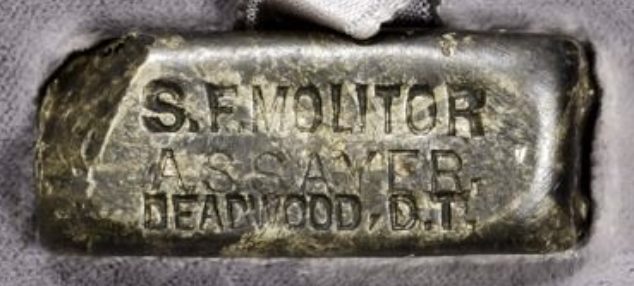
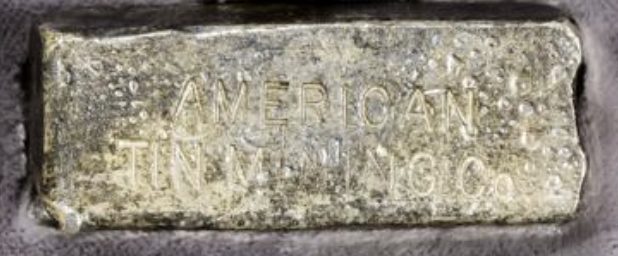
Tin Ingot. About 1 3/8” x ½”. This deep slate-grey ingot is rectangular in shape with a large test wedge taken from the upper left corner of the face.
- Face: S.F. MOLITOR / ASSAYER / DEADWOOD, D.T.
- Back: AMERICAN / TIN MINING CO.;
- the ends and sides are blank.
One of just 5 S.F. Molitor tin ingots known, and incredibly important as such, especially to an ingot aficionado. John Ford’s Collection held but a single tin ingot from this firm, which is not taking anything away from the magnificent Ford holdings – quite the contrary, as it offers a peek into the true rarity of the present tin ingot. If anyone could have found multiple pieces, it would almost certainly have been Ford. The present rarity is from the Kagin Reference Collections, No. 418, and comes housed in a green leatherette box, custom-made to house the piece. Art Kagin Rare – we needn’t say more.
Stephen F. Molitor was born in 1833 in Hungary and came to America as a young man with his father, A.P. Molitor of Wass, Molitor & Co. fame, where he almost immediately became caught up in the happenings of the Gold Rush. S.F. Molitor, assayer, was located for decades in San Francisco, though at various addresses, and was listed in Langley’s San Francisco Directory for the Year nearly continuously from 1858 through 1869. By 1870, S. Molitor had relocated to Montana Territory, where he was first listed in the 1870 Ninth Federal Census, Helena, Montana Territory, Louis and Clark County as an assayer with a net wealth of $3,000. He was listed in the Pacific Coast Directory for 1871-1873 at 43 Main Street, Helena. In 1884-1885, he relocated to Tinton, Dakota Territory, where he formed the American Tin Mining Company and acted as assayer. By 1893 the boom in tin had subsided, and the assaying career of S.F. Molitor was ended as far as we know.
[09/2017] https://www.icollector.com/Dakota-Territory-Deadwood-Stephen-F-Molitor-American-Tin-Mining-Co-Tin-Ingot-About-1-3-8-x_i27907314 ($4,350)
S. F. Molitor Tin Ingot, c 1884, Deadwood, D. T
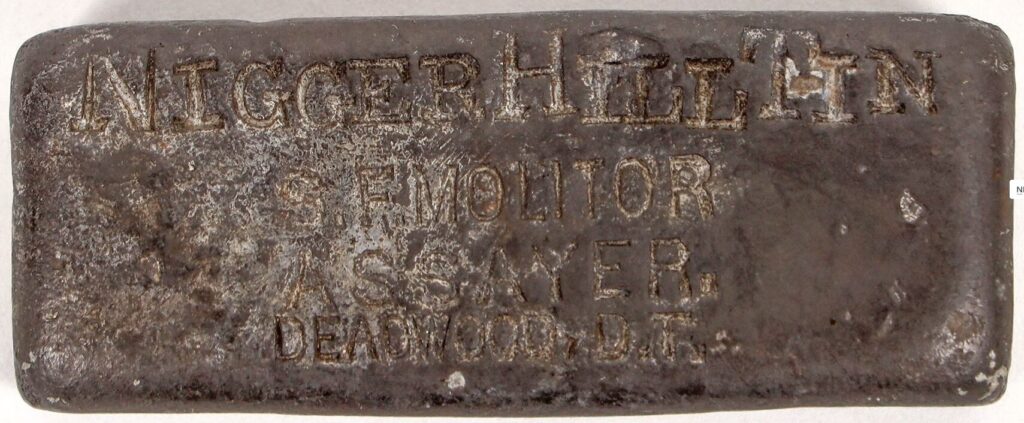
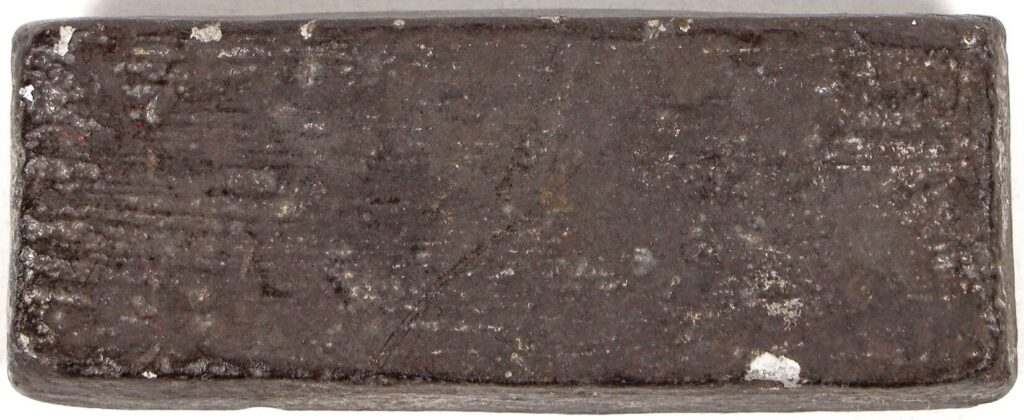
Article below by F. Holabird:
Stephen F. Molitor was the son of famous Gold Rush assayer and coiner A.P. Molitor. I wrote two lengthy articles on Molitor and his tin ingots in 2006 and 2017. Portions of those articles are on line today.
The S.F. Molitor tin ingots are every bit as important as many historical gold ingots for the simple reason that tin was for a short while in the 1880s worth about the same price as gold.
Historians might recall that tin was not new to numismatics, nor new to the world of money. Tin is one of the two major components of bronze; the other being copper. Romans, Greeks and the like regularly used bronze coinage for the lower value coins and money, with silver and gold ranking above them. Tin was the strengthening metal alloy, making the coin less susceptible to corrosion or alteration.
As the industrial revolution in the nineteenth century increased in need, use and technology, tin became more important as an alloy with other metals. Once the demand is high, the search for tin ore deposits was on ñ and America was a hotbed of metals exploration in the nineteenth century because of the huge silver and gold deposits discovered after 1848 (not disrespecting the Appalachian gold belt production of 1828-1848, but that was peanuts compared to California.)
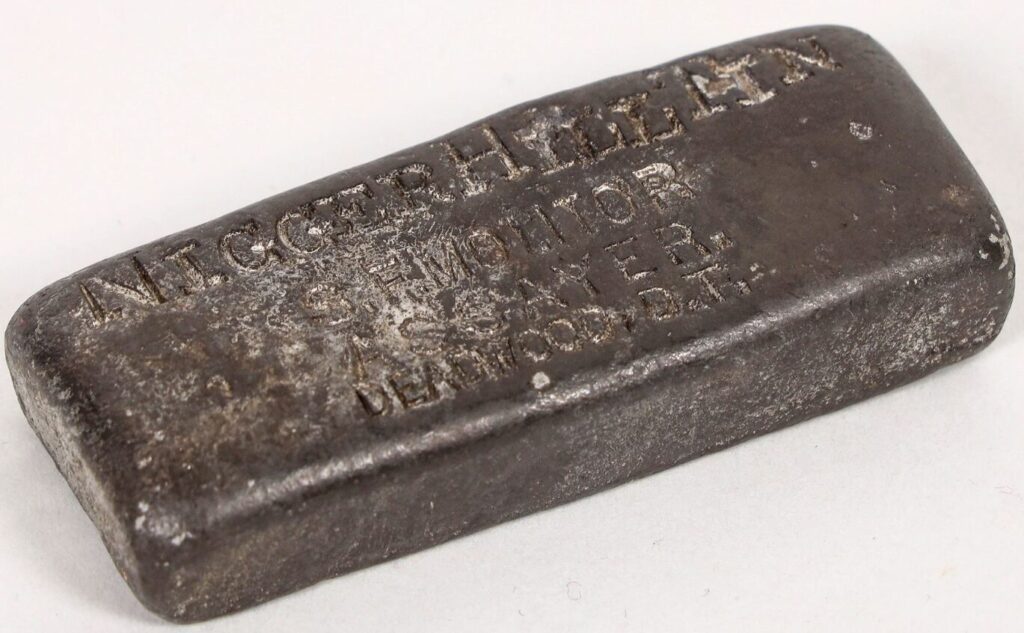
Tin was discovered in the Black Hills in 1876, the Centennial year. One of the earliest discoveries was by an African-American miner near what was later called Tinton. The locale where he made his discovery became known as “N—r Hill” utilizing a cultural name not acceptable today. In truth, the discovery is a testament to the stalwart nature of black miners of the American West, and of the Georgia gold region as well, at least in part. I’ve written about black American miners before, in specific those at Treasure Hill and Hamilton, Nevada in the late 1860s-early 1870s. Out in the far West, miners were miners. They were hard working men of all nationalities, religions and skin colors, particularly California and Nevada. These attributes were only rarely mentioned in news articles, until a bit later when anti-Chinese sentiment grew out of direct competition in a cultural attempt to disallow one group from participation in money-making enterprises.
This ingot is one of two that I know of that sates “N”r Hill” on the ingot itself. All of the Molitor ingots are about the same size, 2″ x 3/4″ x 3/8″ thick. This one weighs 79.1grams, or 2.35 Troy. It is oxidized, thus may have been on public display somewhere for some time. The ingot reads” “Ni..r Hill Tin/ S.F. Molitor/ Deadwood, D. T.” There is nothing on the reverse. The piece is poured in a classic 2 ounce 19th ingot mold. The punches are exactly identical to those on the ingot I pictured on page 46 of my Fall, 2006 catalog.
This ingot is important because of its very rich history, and a testament to American ingenuity during the Industrial Revolution.
[02/2025] https://holabirdamericana.liveauctiongroup.com/Molitor-Tin-Ingot-c-1884-Deadwood-D-T-191676_i55402843 ($5,312)
Stephen F. Molitor “N—r Hill” Tin Ingot, Deadwood, D.T
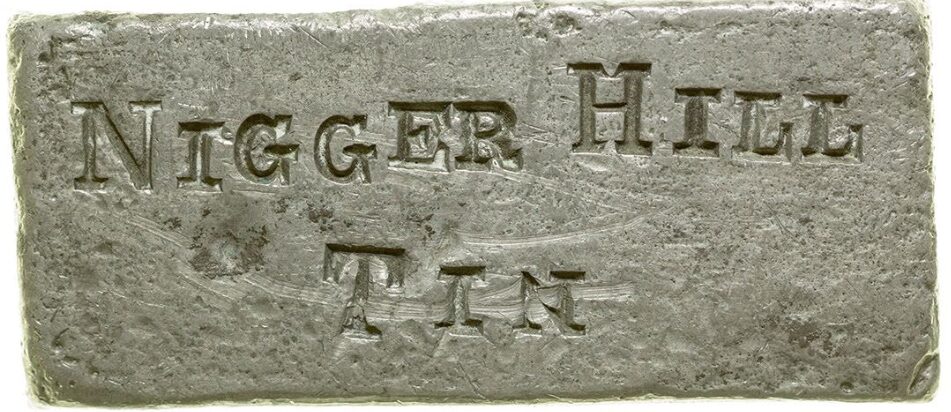
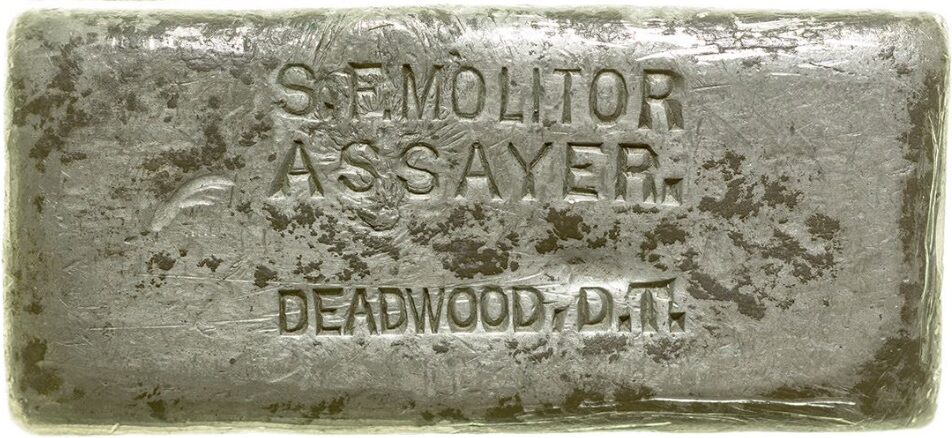
This is the largest of only five known (now six as of 2025) tin ingots from San Francisco assayer Stephen Molitor. Stamped “Nigger Hill Tin” on one side and “Stephen F. Molitor / Assayer / Deadwood, D.T.” on the other. The ingot measures one inch high, two inches wide and one inch deep. 108.9 grams. Stephen Molitor was the son of A. Molitor, considered one of the great California Gold Rush assayers and one of the men originally involved with the U.S. Assay Office. In January 1859 Augustus and his son formed a new company called S, Molitor and Company. By then Stephen had worked in British Columbia during the Fraser River gold rush of 1857-1858 as well as in San Francisco with his father during earlier years. A third brother named Titus also worked for the firm.
The ingot inscription refers to a tin and gold mining area in the Black Hills of South Dakota, discovered by African Americans. Author Hyman Palais explained the origin of the name of the “Consolidated Nigger Hill Tin Mines” in an article “Black Hills Miners’ Folklore” in California Folklore Quarterly, Vol. 4, No. 3. (July, 1945), pp. 256: “Another story tells how a group of Negroes from Montana came to the Hills in the early days of the gold rush and asked some miners where they should go to work. The miners jokingly advised them to try the top of a near-by hill, the least likely spot they could think of. Much to the surprise of everyone, luck crowned their efforts, and these Negroes found more gold in this out-of-the-way place… than many of the gulch miners had discovered below.” The area was also found to have the largest deposit of tin in North America, so much so that it also became known as “Tinton”.
The provenance of this ingot is from the Fred Dennett Archive (Lot 4202 in this auction.) Dennett was the 32nd Commissioner of the General Land Office, 1908-1913. City: Deadwood State: South Dakota Date: HWAC# 51849
[10/2017] https://holabirdamericana.liveauctiongroup.com/Stephen-F-Molitor-Nigger-Hill-Tin-Ingot-Deadwood-D-T_i28118997 ($4,235)
For more information on his Stephen Molitor’s father, A. P. Molitor, see: https://rareingot.com/a-p-molitor/
